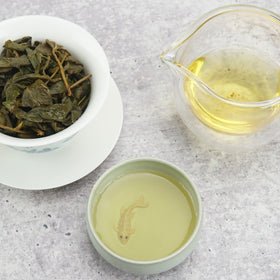
Learn More About Our Ceylon Black Tea
Way back in the late 1800’s Sri Lanka, formerly known as Ceylon, started growing and producing tea. It was a sleepy little enterprise until it gained the attention of an entrepreneurial Scot. This individual whose name would become synonymous with tea was none other than Sir Thomas Lipton. Sir Lipton was already rich because of his chain of grocery stores which started in Scotland and eventually spread throughout Britain. Though as a shrewd businessman Lipton wanted to cut out the middle-men and buy tea directly from producers to make tea affordable for the untapped working class market.

The legacy of the colonial capitalist past lives on in the tea gardens of this emerald isle still bearing quaint English names like Alutenne, Annesley, Belmont, Byrde's Land, Elliewatte, Havelock, Portswood and Tullybody. Notwithstanding its small size, Sri Lanka remains the fourth largest producer of tea in the world after China, India and Kenya. Historically, Sri Lankan tea was used in inexpensive tea bags - which is arguably Sir Lipton's legacy of the country. However, things have changed dramatically to keep up with the current market demands. Now people want higher quality, better tasting tea to be consumed. Sir Lipton just rolled over in his grave!

For the last two years we have been offering an excellent Ceylon black tea from the New Vithanakande Tea farm located in the Ratnapura district. The garden was set up in the 1940s by a local, PBH Pilapitiya, who had once worked in British-owned tea gardens. Currently, Vithanakande sources its green tea leaf from around 6,000 independent small growers who live in the surrounding area. We have seen similar examples of such tea gardens in south Asia, and feel this is a good way to spread the economic benefit throughout the wider community. This "decentralized" approach is a fairly new phenomenon in the tea industry and we hope to see it grow.
We were drawn to Vithanakande teas after tasting them at a trade expo. They are complex yet nuanced, rich yet very balanced in the cup. Notes of honey and molasses dominate. You can drink it straight up and enjoy the smooth, rich flavors and the inherent sweetness of the tea. Or, add a spot of milk and sugar if it makes you merrier.

One day we would like to visit Sri Lanka. Not just for its hills of tea, but the splendid tropical vistas and rich culture. The population is largely Buddhist, following a more conservative Theravada lineage. The architecture, especially the traditional buildings and temples, resembles the Dravidian style found in southern India. Thankfully, the island nation seems to have largely put behind the bloody civil war of the 1980s and 1990s. Hopefully they will thoughtfully evolve their tea industry and other industries to protect their fragile ecosystem. We invite you to learn more about Sri Lanka and try this gorgeous brew. Stay well!


